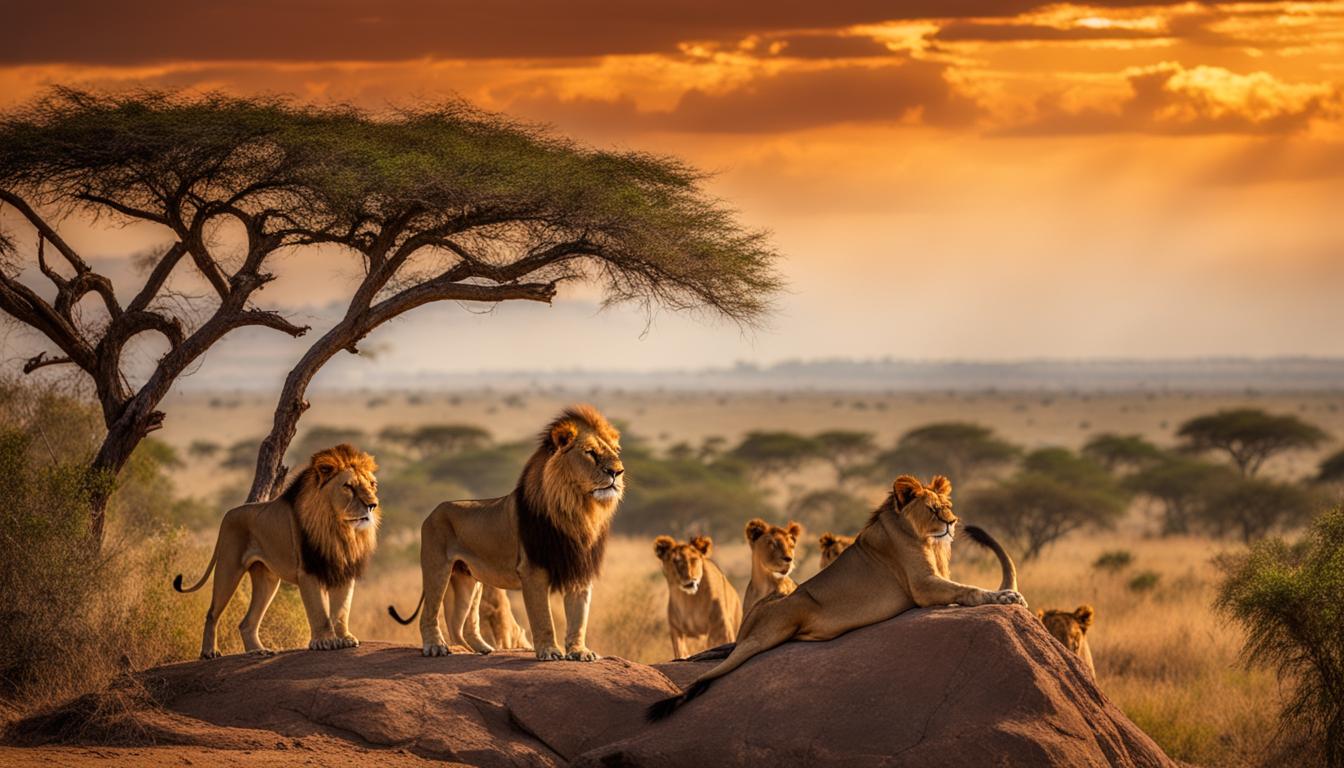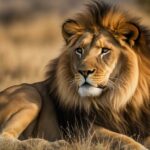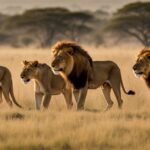Lions are one of Africa’s most recognizable animals, representing courage, strength, and power. These majestic creatures spend up to 20 hours a day sleeping or resting, earning their title as the laziest big cats. Living in prides, lions are social beings, with related females, their offspring, and a few males forming a close-knit community. While they primarily prey on large herbivores, lions are versatile hunters capable of taking down smaller animals as well.
Communication plays a vital role in a lion’s life, with sounds, scent markings, and visual signals serving as their means of interaction. Interestingly, it is the lioness who takes charge of hunting, using teamwork to successfully bring down prey. Additionally, female lions raise their cubs together in a nursery group, while male cubs venture out to find their own pride as they mature. Lions are the second-largest cat species, with males growing up to 10 feet in length and weighing up to 550 pounds. Despite being commonly associated with the “king of the jungle” moniker, lions actually inhabit grasslands and plains.
Key Takeaways:
- Lions are known for their lazy nature, spending up to 20 hours a day sleeping or resting.
- Lions live in social groups called prides, consisting of related females, their offspring, and a few males.
- They communicate through sounds, scent markings, and visual signals.
- Lionesses do most of the hunting, utilizing teamwork to bring down prey.
- Lions are the second-largest cat species, with males growing up to 10 feet in length and weighing up to 550 pounds.
Lion Habitat and Populations
Lions are highly adaptable animals that can be found in a variety of habitats, ranging from savannahs and grasslands to woodlands. They are most commonly associated with the African continent, with the majority of lion populations residing in sub-Saharan Africa. However, it is important to note that lions also have a presence in Asia, specifically in the Gir Forest of India.
Despite their ability to adapt, lion populations across Africa have been facing significant declines. They have disappeared from many areas where they once roamed freely. It is estimated that there are currently between 20,000 and 23,000 African lions remaining in the wild. This alarming decline in population can be attributed to various factors, including habitat loss, human-wildlife conflict, and trophy hunting.
To better understand the current status of lion populations, it is essential to support conservation efforts and initiatives. Several organizations are dedicated to protecting lions and their habitats, working towards ensuring the long-term survival of these majestic creatures. By supporting these organizations and spreading awareness about lion conservation, we can contribute to the preservation of lion populations for future generations.
| Lion Habitat and Populations | |
|---|---|
| African Lions | Asiatic Lions |
| Estimated population: 20,000-23,000 | Estimated population: 600 |
| Primary habitat: Sub-Saharan Africa | Primary habitat: Gir Forest, India |
| Main threats: Habitat loss, human-wildlife conflict, trophy hunting | Main threats: Habitat loss, poaching |
| Conservation organizations: Lion Recovery Fund, Panthera | Conservation organizations: Gir National Park and Wildlife Sanctuary, Wildlife Trust of India |
Lion Behavior and Hunting
Lions exhibit fascinating behaviors and hunting strategies that make them one of the most intriguing species in the animal kingdom. Understanding their behavior and hunting techniques gives us a deeper appreciation of these majestic creatures.
Communication and Social Structure
Lions are highly social animals, and their interactions within prides are complex and dynamic. Communication plays a crucial role in maintaining social bonds and coordinating hunting efforts. Lions communicate through a combination of vocalizations, scent markings, and visual signals. The iconic roar of a lion can be heard up to 5 miles away, serving as a territorial declaration and a way to communicate with other prides.
Within a pride, lionesses work together to hunt and bring down prey. Their coordinated efforts involve strategic positioning, the use of teamwork, and a keen sense of observation. By hunting in groups, lionesses increase their chances of successfully capturing larger herbivores, such as zebras and wildebeests, which are essential for sustaining the pride.
Hunting Techniques
Lions are masters of ambush hunting. They have well-developed vision and can spot potential prey from a distance. Once a suitable target is identified, lions approach their prey stealthily, minimizing the chance of being detected. Their muscular bodies and retractable claws give them excellent control and speed during the chase.
When hunting, lions deploy various tactics to outmaneuver and bring down their prey. They often adopt a strategy referred to as the “stalk and pounce,” where they silently approach their target before launching a sudden and powerful attack. Lions can reach speeds of up to 50 miles per hour in short bursts, allowing them to catch their prey off guard.
Lions’ hunting techniques are not only focused on capturing food but also on minimizing the risk of injury. By strategically targeting vulnerable areas, such as the neck or throat, they aim to quickly incapacitate their prey, ensuring a swift and efficient kill.
Complete the table below with relevant data:| Lion Behavior | Hunting Techniques |
|---|---|
| Highly social animals | Ambush hunting |
| Communication through vocalizations, scent markings, and visual signals | Stalk and pounce strategy |
| Female lions hunt in groups, coordinating efforts and increasing success rates | Average speed of 50 miles per hour during the chase |
| Males protect the pride and territory, participate in hunting larger prey | Precise targeting of vulnerable areas to ensure a swift kill |
Lion Diet and Adaptations
Lions are apex predators known for their incredible hunting abilities and adaptations that help them thrive in their environments. Their diet primarily consists of large herbivores, but they also have the capability to hunt smaller animals. Let’s explore the lion’s diet and the fascinating adaptations that make them successful hunters.
Lion Diet
Lions primarily prey on large herbivores such as zebra, wildebeest, and buffalo. These animals provide the necessary sustenance for the pride, as they are a rich source of protein and nutrients. Lions are well-equipped for taking down such prey, with their sharp teeth and powerful jaws capable of delivering a fatal bite. They use their strength and coordinated hunting strategies to overpower and bring down these larger animals.
However, lions are opportunistic hunters and will also target smaller animals when the opportunity arises. They have been known to hunt mice, birds, hares, lizards, and even tortoises. This flexibility in their diet helps lions survive during times when larger prey is scarce. It showcases their adaptability and resourcefulness in the harsh African savannahs and grasslands where they reside.
Lion Adaptations
Lions have evolved several adaptations that enable them to excel in their environments and secure their position as apex predators. One of their most striking adaptations is their tan-colored coat, which allows them to blend into the surrounding grasslands and remain hidden from their prey. This camouflage enhances their chances of a successful ambush, as they can approach their targets undetected.
In addition to their camouflage, lions have powerful limbs and retractable claws that provide them with excellent control and speed. This allows them to chase down their prey with agility and execute precise maneuvers during the hunt. With speeds of up to 50 miles per hour and the ability to jump up to 36 feet, lions are formidable predators that strike fear into the hearts of their prey.
| Adaptation | Description |
|---|---|
| Tan-colored coat | Allows lions to blend into the grasslands and ambush prey. |
| Powerful limbs | Provide speed and agility during the chase. |
| Retractable claws | Offer control and precise maneuverability. |
These adaptations, combined with their incredible strength and hunting strategies, make lions highly efficient predators. They are apex predators in their ecosystems and have no natural predators. Lions play a crucial role in maintaining the balance of the ecosystem by controlling herbivore populations and preventing overgrazing of vegetation. They are truly remarkable animals that have adapted to thrive and survive in their challenging habitats.
Lion Cub Development
Watching lion cubs grow and develop is a fascinating glimpse into the circle of life. From their vulnerable and dependent state at birth to becoming strong and independent adults, lion cubs go through several stages of development. Let’s explore the incredible journey of lion cub growth.
Stage 1: Birth and Early Parenthood
When lion cubs are born, they weigh around 3 to 4 pounds and are blind for the first two to three weeks. They rely completely on their mothers for nourishment and protection. Lionesses in a pride often give birth around the same time, creating a communal nursery group where cubs can grow and learn together. This shared parenting dynamic helps in the survival and overall well-being of the young ones.
Stage 2: Exploration and Play
As the lion cubs grow, their curiosity and energy start to emerge. At around three months old, they begin venturing out of the den under the watchful eye of their mothers. Play is an essential part of their development, as it helps them build their strength, coordination, and social skills. They engage in mock fights, pouncing on each other, and chasing their tails, all while sharpening their hunting instincts. This playful behavior prepares them for the future challenges they will face as adults.
Stage 3: Becoming Independent
As they reach adolescence, male lion cubs and some female cubs face a pivotal moment in their lives. To avoid competition with the dominant male, they are forced to leave the pride when they are around two to three years old. This period of separation is challenging, as they need to learn to hunt and survive on their own. However, it allows them to search for new territories and establish their own prides, contributing to the genetic diversity and overall health of lion populations.
| Stage of Lion Cub Development | Description |
|---|---|
| Birth and Early Parenthood | Cubs are born blind and reliant on their mothers for care and protection. |
| Exploration and Play | Cubs begin to venture out, engaging in playful activities to develop their skills. |
| Becoming Independent | Male cubs and some female cubs leave the pride to establish their own territories. |
“Watching lion cubs grow and mature is a reminder of the resilience and adaptability of these magnificent creatures.” – Wildlife enthusiast
Conclusion
Lions are magnificent creatures that captivate our imagination with their strength and beauty. Unfortunately, their populations are facing significant threats and are on a steady decline. Human activities such as habitat loss and trophy hunting have taken a toll on these iconic animals.
However, there is hope. Lion conservation organizations are working tirelessly to protect these endangered species and their habitats. By supporting these organizations, you can make a meaningful impact in preserving the future of lions.
It is crucial to raise awareness about the importance of lion conservation and the need to protect these incredible creatures. Through education, advocacy, and supporting wildlife conservation initiatives, we can ensure that lions continue to roam the wild and inspire awe and admiration for generations to come.
What Does the Color of a Bald Eagle’s Eyes Reveal About Them?
The color of bald eagles’ eyes serves as a valuable clue about their age and maturity. Young eagles have brown eyes, gradually transitioning to yellow during adolescence, and finally reaching a striking golden color once they become adults. This transformation helps researchers and enthusiasts identify their approximate age and stage of life.
FAQ
What are some interesting facts about lions?
Lions are one of Africa’s most recognizable animals, symbolizing courage, strength, and power. They are the laziest big cats, spending up to 20 hours a day sleeping or resting. Lions are social animals that live in prides, consisting of related females, their offspring, and a few males. They primarily prey on large herbivores but can also hunt smaller animals. Lions communicate through sounds, scent markings, and visual signals.
Where can lions be found?
Lions can be found in both Africa and Asia, with the majority of populations residing in sub-Saharan Africa. They adapt to various habitats, including savannahs, grasslands, and woodlands. However, lion populations across Africa have been declining and have disappeared from many areas. It is estimated that there are between 20,000 and 23,000 African lions remaining in the wild. Additionally, there are approximately 600 Asiatic lions in the Gir Forest of India.
How do lions hunt?
Female lions in a pride are the primary hunters, working together to bring down prey. Males participate in hunting larger prey and focus on protecting the pride and territory. Lions hunt by ambush, using their excellent vision and retractable claws for control and speed. They can reach speeds of up to 50 miles per hour and jump up to 36 feet. Lions are known for their loud roars, which can be heard up to 5 miles away and serve as a form of communication, warning, and territorial defense. They are also active mainly during the night, being nocturnal animals.
What do lions eat?
Lions primarily prey on large herbivores such as zebra, wildebeest, and buffalo. However, they can also hunt smaller animals like mice, birds, hares, lizards, and tortoises. Lions have adapted to their habitats over time, with their tan-colored coat allowing them to blend in with the surroundings. Lions living in desert regions have smaller manes to keep them cool. They have no natural predators and are apex predators in their ecosystems.
How do lion cubs develop?
Lion cubs are born small and helpless, with their eyes closed for the first two to three weeks. They rely on their mothers for care and protection, and the lionesses in a pride will raise their cubs communally. Cubs start playing and interacting with other youngsters in the pride, which helps build strength and family bonds. Male lion cubs and some female cubs are forced to leave the pride when they reach a certain age to prevent competition with the dominant male. Lions have a unique social structure and parenting dynamics.
How can we support lion conservation?
Lions are magnificent animals that captivate our imagination. However, their populations are declining, primarily due to human factors such as habitat loss and trophy hunting. It is important to support lion conservation efforts and organizations focused on protecting these endangered species. By raising awareness, taking action, and supporting wildlife conservation initiatives, we can ensure a future where lions continue to roam the wild and inspire awe and admiration.











